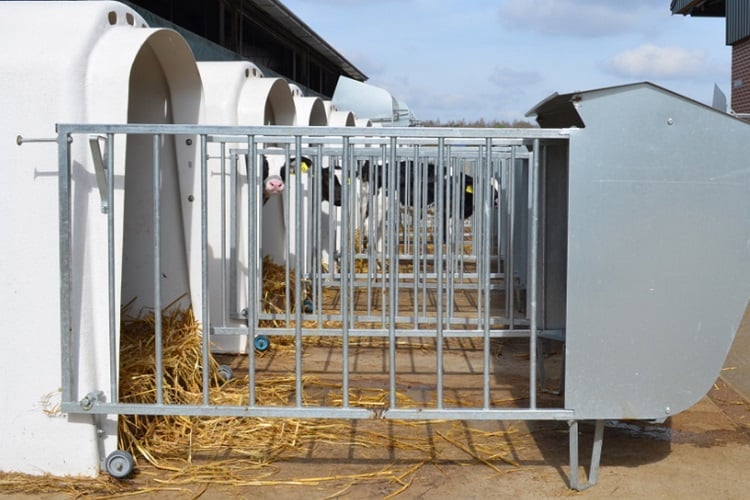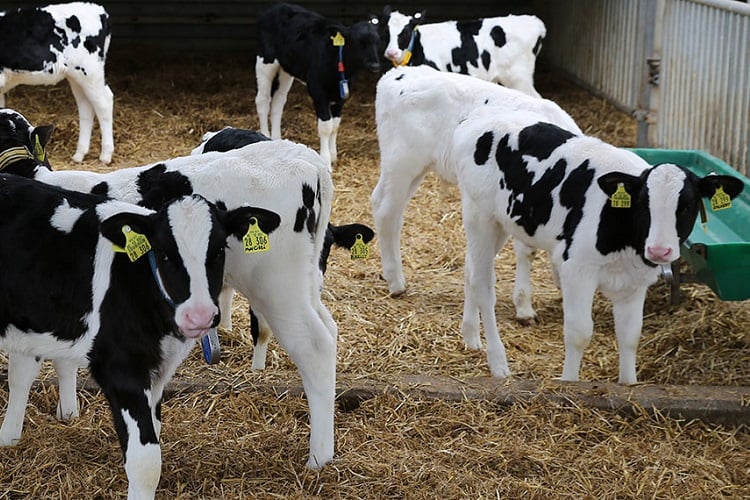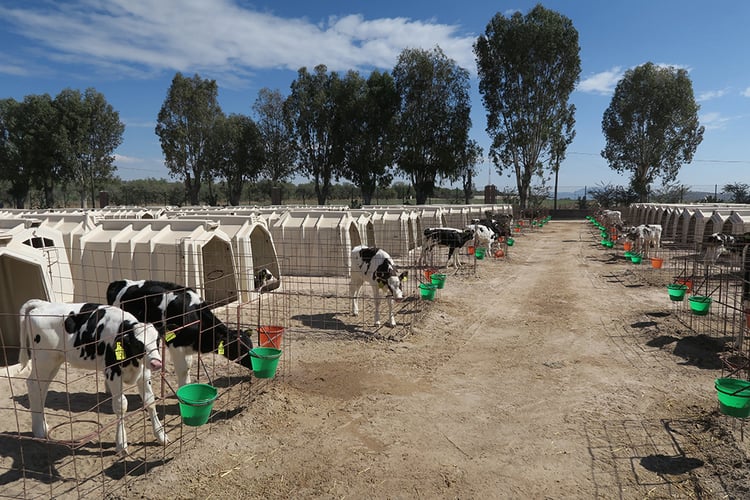- LifeStart
- Preweaning
Key takeaways from the research
-
Milk intake of dairy calves fed ad libitum increases with milk allowance.
-
Calves on restricted feeding schedules exhibit signs of hunger and stress both prior to and during weaning.
-
Calf starter intakes are higher in calves allowed less milk, but with proper weaning management, calves fed higher planes of nutrition can have a smooth weaning transition.
-
Calves fed higher planes of pre-weaning nutrition gain more weight and this higher body weight can be maintained after weaning with proper management.
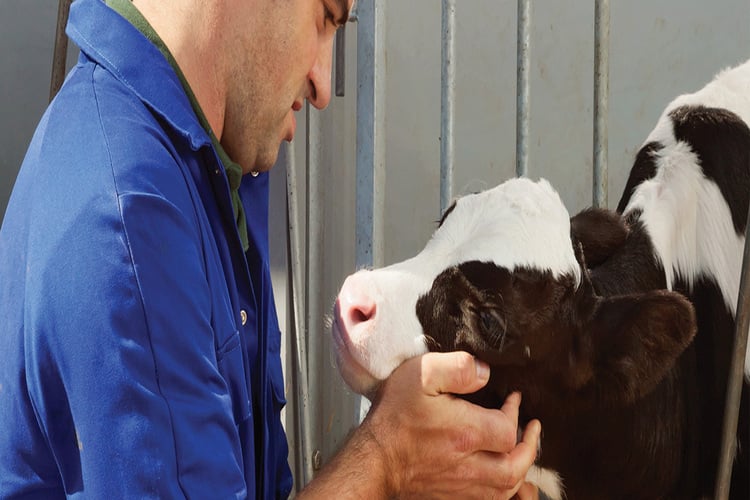
How milk allowance affects milk and starter intake, behaviour and weight gain in dairy calves
If conventional milk feeding rates of 10% of a calf’s birth weight are still being used[1] with an aim to stimulate solid feed intake, calves are likely to experience hunger[2] and lower growth rates.[3] Dairy farms are increasingly choosing to feed calves higher planes of pre-weaning nutrition to support greater growth.[4] If these higher feeding planes are combined with additional management to increase starter intake prior to weaning, such as using gradual weaning methods[5] and social housing,[6] they will result in improved weight gains and better calf welfare.[7]
In their research entitled, “The effect of milk allowance on behavior and weight gain in dairy calves,” Rosenberger, et al.[8] studied the short- and long-term effects of a variety of milk allowances on feed intake, behaviour and body weight. They also reviewed calf management interventions required if higher planes of pre-weaning nutrition are being applied.
Study design
Fifty-six Holstein calves were randomly assigned to 1 of 4 feeding treatments (6, 8, 10 or 12 L/d) of whole milk. At day 42, their milk allowance was reduced by half, followed by an additional reduction of 20% per day, beginning at day 50. All calves were fully weaned by day 55. Throughout the study, calves had ad libitum access to both hay and starter feed.
Body weights were measured between 2 and 10 weeks of age. Daily intakes of milk and starter were recorded, and unrewarded trips to the automated feeder were counted as well. Average daily gain, feed ratio and body weight were recorded throughout the study and weekly health checks were performed.
Results
Milk consumption: Milk intake did increase with milk allowance, although none of the calves consumed to the limit of their allowance. For example, on average, 5.66L p/d was consumed by the 6L calves and 9.4L p/d was consumed by the 12L calves, prior to beginning step-down weaning.
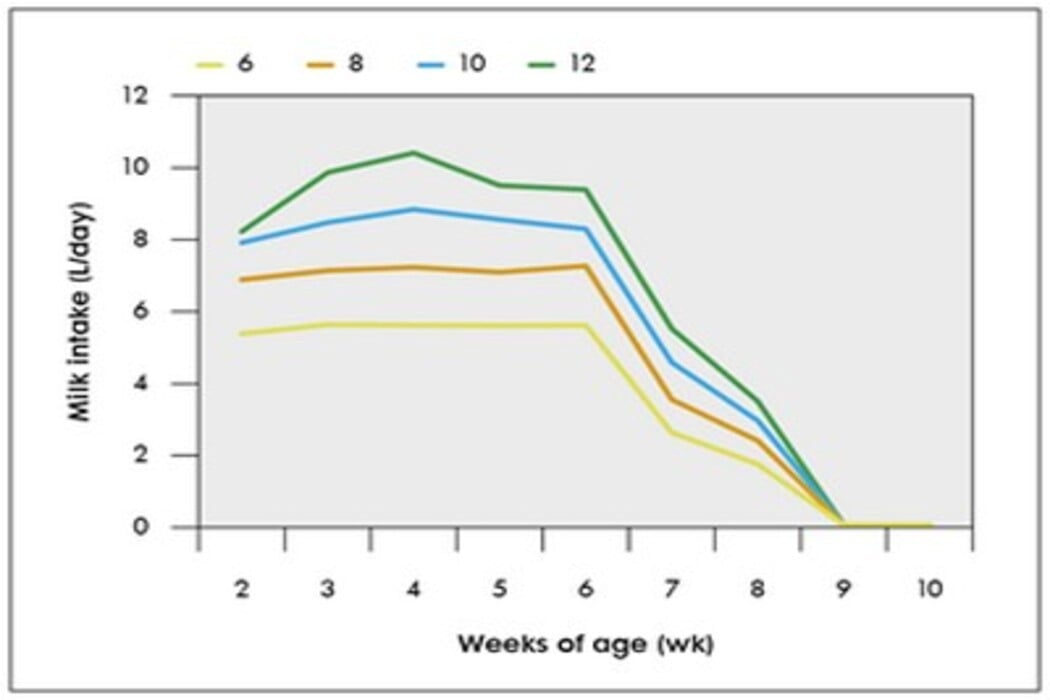
Rewarded and unrewarded visits to the feeder: Calves allowed less milk had more unrewarded visits to the feeder than those with a higher milk allowance (averaging 11.1 p/d for the 6L calves compared with 0.4 p/d for the 12L calves, pre-weaning). These unrewarded visits are indicative of hunger, which is a finding supported by previous studies.[9] While unrewarded visits did increase during weaning for all treatments, calves with a higher milk allowance still had fewer unrewarded visits.
Calf starter intakes: Prior to weaning, intake of calf starter was higher for calves fed less milk. For example, the 6L calves consumed 0.25 kg/d whereas the 12L calves consumed only 0.05 kg/d. While differences in starter consumption between the treatments continued during weaning (6L calves averaged 1.15 kg/d compared to the 12L calves at 0.54 kg/d), there was no difference in starter consumption after weaning, with all treatments consuming almost 3 kg/d. As consuming more starter prior to weaning can ease the transition from milk to solid feed, management is required to stimulate interest in solid feed. The present study utilised several techniques to do so including using a step-down weaning process, providing access to forage, and housing calves socially. Socially housed calves have less phobia of new foods[10] and tend to have higher pre-weaning starter intakes.[11]
Growth in the short- and long-term: Average daily gain was higher in calves fed more milk, with the 6L calves averaging 770 g/d compared to the 12L calves at 900 g/d. The benefits of feeding more milk persisted so over the course of the entire study, average daily gain was higher in calves fed more milk. This is consistent with previous studies.[12] Due to appropriate weaning management, the body weight advantage of the 12L calves remained both during and after weaning. Additionally, feeding higher amounts of milk may have positive effects on both long-term production and reproduction.[
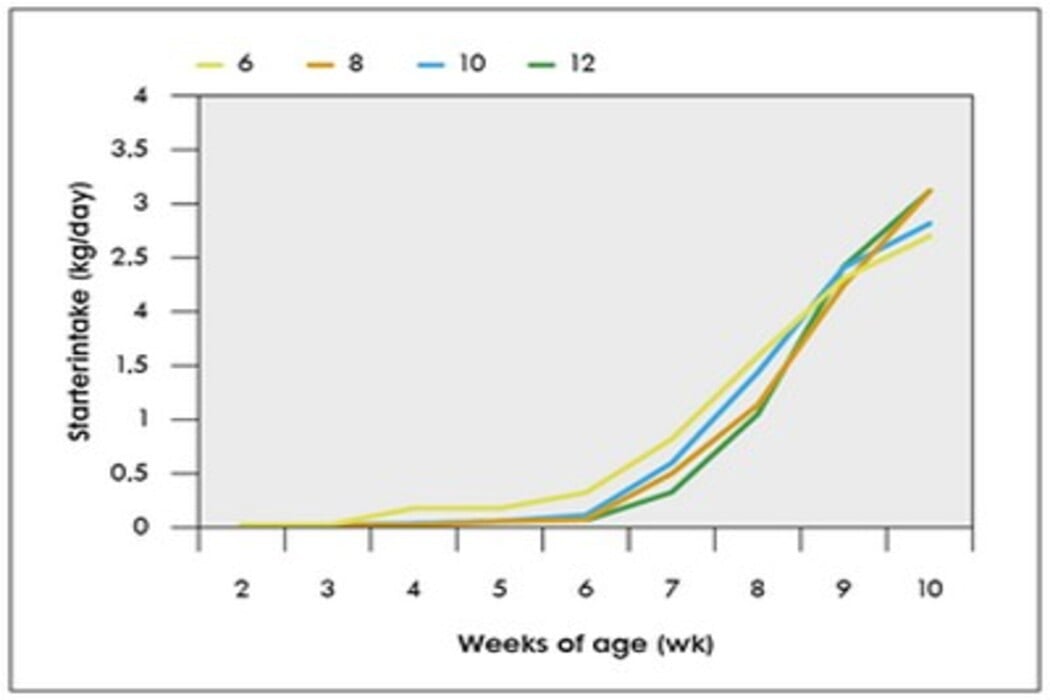
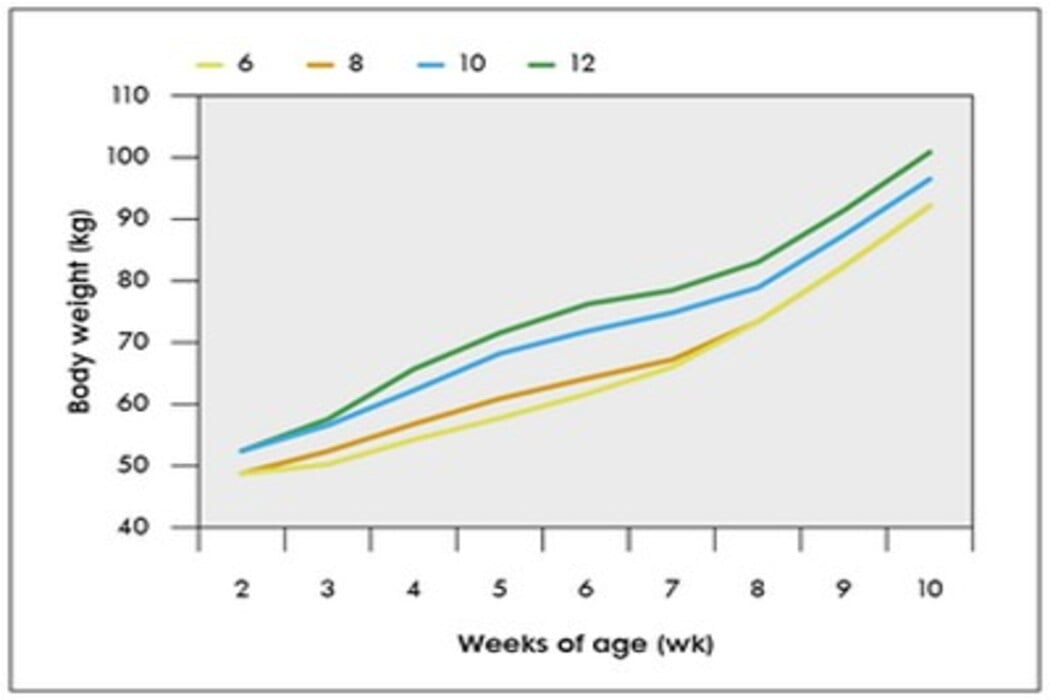
Conclusion
This study confirms that calves given ad libitum access to milk can indeed consume very high quantities. The high number of unrewarded trips to the feeder for calves with lower milk rations shows that calves fed restricted amounts of milk experience hunger throughout both the pre-weaning and weaning periods. This has serious implications for calf welfare. To decrease stress at weaning for calves fed higher amounts of milk, management techniques to smoothen the transition are important. If managed properly, however, the higher average daily gain resulting from a higher pre-weaning plane of nutrition can persist long after weaning.
References
[1] * Dairy Cattle Management Practices in the United States, 2014. NAHMS #692.0216. USDA-Animal and Plant Health Inspection Service (APHIS)-Veterinary Services (VS)- Center for Epidemiology and Health (CEAH), Fort Collins, CO*
[2] Thomas, T.J., Weary, D.M., Appleby, M.C. Newborn and 5-week old calves vocalize in response to milk deprivation. Appl. Anim. Behav. Sci. 2001; 74:165–173.
[3] Miller-Cushon, E. K., R. Bergeron, K. E. Leslie, and T. J. Devries. 2013a. Effect of milk feeding level on development of feeding behavior in dairy calves. J. Dairy Sci. 96:551–564.
[4] Appleby, M.C., Weary, D.M., Chua, B. Performance and feeding behavior of calves on ad libitum milk from artificial teats. Appl. Anim. Behav. Sci. 2001; 74:191–201. Diaz, M.C., Van Amburgh, M.E., Smith, J.M., Kelsey, J.M., Hutten, E.L. Composition of growth of Holstein calves fed milk replacer from birth to 105-kilogram body weight. J. Dairy Sci. 2001; 84:830–842. Khan, M.A., Weary, D.M., von Keyserlingk, M.A.G. Invited review: Effects of milk ration on solid feed intake, weaning, and performance in dairy heifers. J. Dairy Sci. 2011; 94:1071–1081. And Kiezebrink, D.J., Edwards, A.M., Wright, T.C., Cant, J.P., Osborne, V.R. Effect of enhanced whole-milk feeding in calves on subsequent first-lactation performance. J. Dairy Sci. 2015; 98:349–356.
[5] Khan, M.A., Lee, H.J., Lee, W.S., Kim, H.S., Kim, S.B., Ki, K.S., Ha, J.K., Lee, H.G., Choi, Y.J. Pre- and postweaning performance of Holstein female calves fed milk through step-down and conventional methods. J. Dairy Sci. 2007; 90: 876–885.
[6] Costa, J.H.C., Meagher, R.K., von Keyserlingk, M.A.G., Weary, D.M. Early pair housing increases solid feed intake and weight gains in dairy calves. J. Dairy Sci. 2015; 98:6381–6386. Costa, J.H.C., von Keyserlingk, M.A.G., Weary, D.M. Invited review: Effects of group housing of dairy calves on behavior, cognition, performance, and health. J. Dairy Sci. 2016; 99:2453–2467. And Jensen, M.B., Duve, L.R., Weary, D.M. Pair housing and enhanced milk allowance increase play behavior and improve performance in dairy calves. J. Dairy Sci. 2015; 98:2568–2575.
[7] Khan et al. 2011. Ibid.
[8] Rosenberger, K., Costa, J.H.C., Neave, H.W., von Keyserlingk, M.A.G., and Weary, D.M. The effect of milk allowance on behavior and weight gains in dairy calves. J. Dairy Sci. 2017; 100:504–512.
[9] de Paula Vieira, A., Guesdon, V., de Passillé, A.M., von Keyserlingk, M.A.G., Weary, D.M. Behavioral indicators of hunger in dairy calves. Appl. Anim. Behav. Sci. 2008; 109:180–189. Jensen, M.B., Holm, L. The effect of milk flow rate and milk allowance on feeding related behavior in dairy calves fed by computer-controlled milk feeders. Appl. Anim. Behav. Sci. 2003; 82:87–100. Nielsen, P.P., Jensen, M.B., Lidfors, L. Milk allowance and weaning method affect the use of a computer controlled milk feeder and the development of cross-sucking in dairy calves. Appl. Anim. Behav. Sci. 2008; 109:223–237.
[10] Costa, J.H.C., Daros, R.R., von Keyserlingk, M.A.G., Weary, D.M. Complex social housing reduces food neophobia in dairy calves. J. Dairy Sci. 2014; 97:7804–7810.
[11] de Paula Vieira, A., de Passilé, A.M., Weary, D.M. Effects of the early social environment on the behavioural responses of dairy calves to novel events. J. Dairy Sci. 2012; 95:5149–5155. Costa, J.H.C., von Keyserlingk, M.A.G., Weary, D.M. Invited review: Effects of group housing of dairy calves on behavior, cognition, performance, and health. J. Dairy Sci. 2016; 99:2453–2467.
[12] Diaz, M.C., M.E. Van Amburgh, J.M. Smith, J.M. Kelsey, and E.L. Hutten, 2001. Composition of growth of Holstein calves fed milk replacer from birth to 105- kilogram body weight. J. Dairy Sci. 84: 830 – 842. And Cowles, K.E., R.A. White, N.L. Whitehouse, and P.S. Erickson, 2006. Growth characteristics of calves fed an intensified milk replacer regimen with additional lactoferrin. J. Dairy Sci. 89: 4835 – 4845.
[13] Davis Rincker, L.E., VandeHaar, M.J., Wolf, C.A., Liesman, J.S., Chapin, L.T., Weber Nielsen, M.S.Effect of intensified feeding of heifer calves on growth, pubertal age, calving age, milk yield, and economics. J. Dairy Sci. 2011; 94:3554–3567. Soberon, F., Raffrenato, E., Everett, R.W., Van Amburgh, M.E. Preweaning milk replacer intake and effects on long-term productivity of dairy calves. J. Dairy Sci. 2012; 95:783–793. Soberon, F., Van Amburgh, M.E. Lactation Biology Symposium: The effect of nutrient intake from milk or milk replacer of preweaned dairy calves on lactation milk yield as adults: A meta-analysis of current data. J. Anim. Sci. 2013; 91:706–712.

